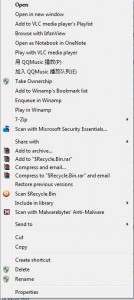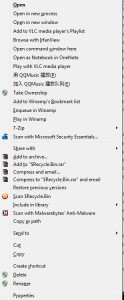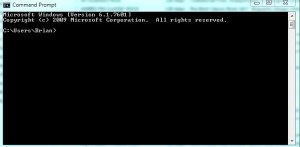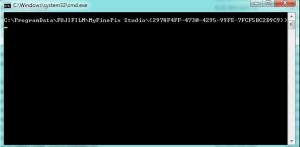Sometimes when we save a complete web page, as suggested in a previous post, we get a series of proxy files instead of .jpg files. Sure, we can right click each picture and save it individually but if there are fifty photos on the page, that takes a lot of time. Here’s an example of a page that I would normally save, just to get the photos: http://www.howtobearetronaut.com/2011/09/polaroids-1970s-by-anthony-perkins/
This is from one of my favorite sites, full of interesting photos of very unique parts of our history. If you look at the page, you’ll see a string of family photos from Anthony Perkins, maybe ten or so. I could right click and save these in a short time but this is an example, just to show you what can be done if there are thirty, fifty or a hundred photos on a page.
Instead of linking each photo to a .jpg file in a folder on the server, this page uses proxy files to feed the images. This is a more secure way to link pictures and their source on a website. Once you have downloaded this page, this is what you will see in the site folder on your computer:
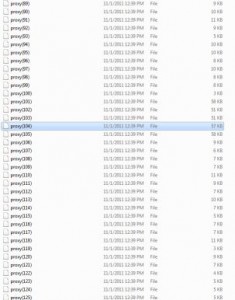
Where you usually see .jpg files, in this case you will see proxy files. Actually, at this point, they aren’t even files since they don’t have any extension. Again, we could rename each one and add the .jpg file extension to it but you can see how long that would take. How can we rename and add a file extension more easily than that?
Yesterday, I wrote about adding a command window to our right click menu. That post is here. These are the steps that will make renaming and adding a file extension to all of these files a very simple job.
1. First, you need to separate the proxy files from the rest of the files in the folder. Create a new folder anywhere on your computer. Put one right on your desktop, if you want. Highlight all of the proxy files, right click them and choose copy. Paste them into the new folder that you created.
2. You will notice that there are far more proxy files in the folder than there were full size photos in the page. Don’t worry about that now.
3. This will be a two step process, only one of which uses the command prompt. Open the new folder, if it isn’t already, and highlight all the proxy files. We’re going to rename all the files at once, changing the ‘proxy(x)’ to something like ‘Polaroidx’. Highlight all of the files using Control/A (select all). Right click the blue selection and choose ‘Rename’. One of the files will show a flashing menu where you can type Poloroid like this:
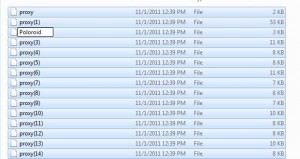
Hit enter and every file in the folder will be renamed Polaroid, Polaroid1, Polaroid2, etc. That was quick, right? You can do this with any folder that you have, renaming your DSC files to something that sounds friendlier, for example. OK, the files are now renamed but they are still useless to use since we can’t open them, right? Back out of this folder but keep it in front of you on the desktop.
3. Holding down the Shift key, right click the folder and choose ‘open command window here’.
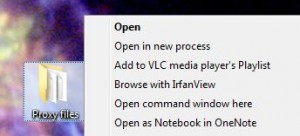
4. A black background window with some white type on it will pop up. This is your command window, a very powerful (and fast) tool, if you know what you’re doing. Here’s the menu you should be seeing:
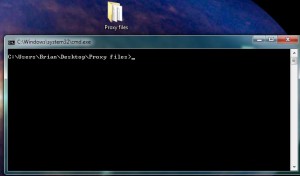
5. Here is where you can perform actions on the folder or everything in the folder. Click anywhere in the window to activate it, then type this:
ren * *.jpg (like this: )
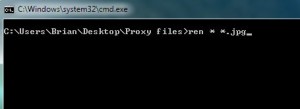
OK, the ‘ren’ means ‘rename’. The ‘*’ means everything or all. The *.jpg means to rename everything that has a name before the period to the same name but add .jpg after the period. You can use ‘rename’ too but why bother?
5. Once you have typed EXACTLY what you see here, hit enter. The command window flashes and then sits quietly, waiting for more commands. Since we don’t need it anymore, close the window.
6. Open the folder and you’ll see this:
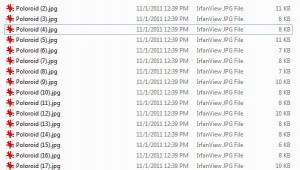
The next steps depend on what you’ve saved in the first place. In this case, some of the files are full-size, some are tiny. You’ll have to figure out which ones are the ones you want. Go up to the top right and change ‘details’ to ‘large icon’, then click each photo you want to save while holding the Control key. Once you’ve got them all selected, move them to another folder and delete the current folder.
TIP: If you know something about DOS, it would be easy to both rename the files and add the files extension in one step but I thought this would be less confusing. The simple ‘ren * *.jpg’ statement is far less confusing, in my opinion.
Thanks for reading!

